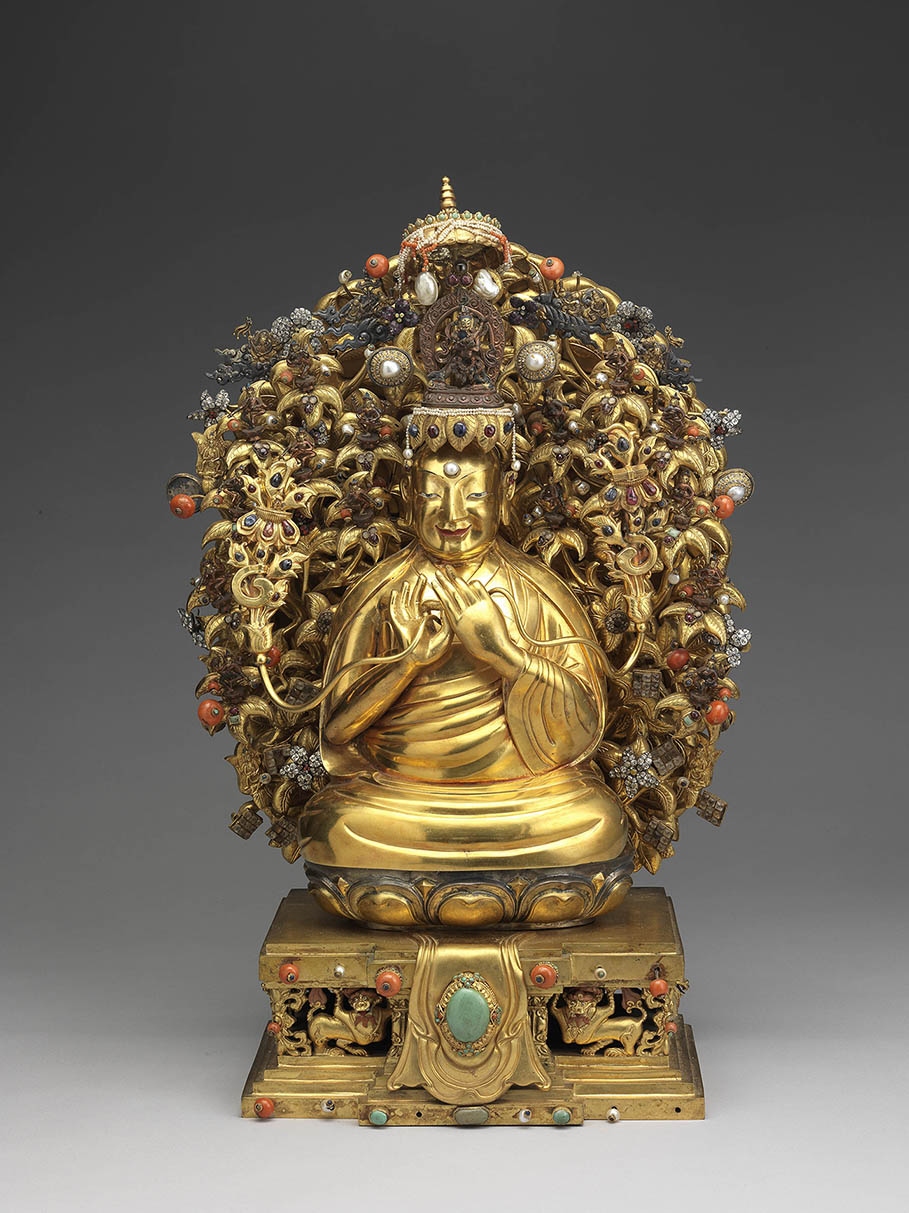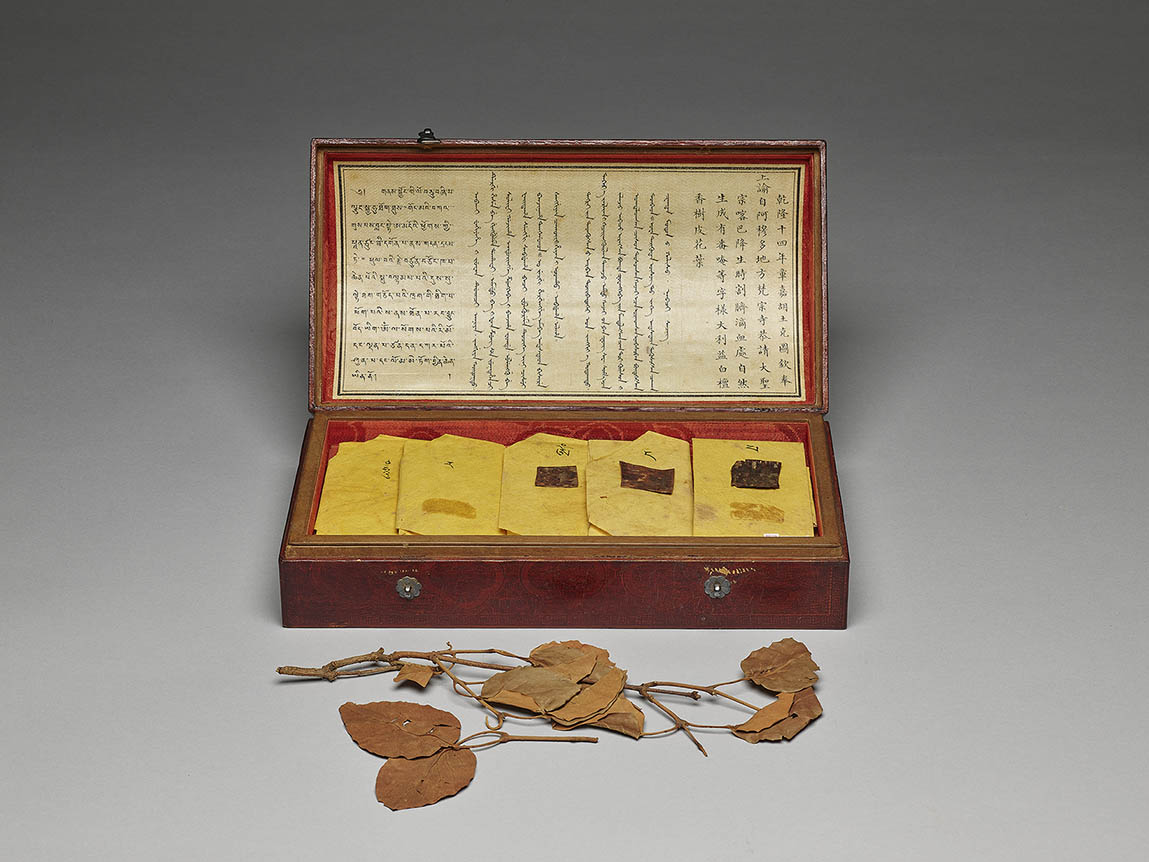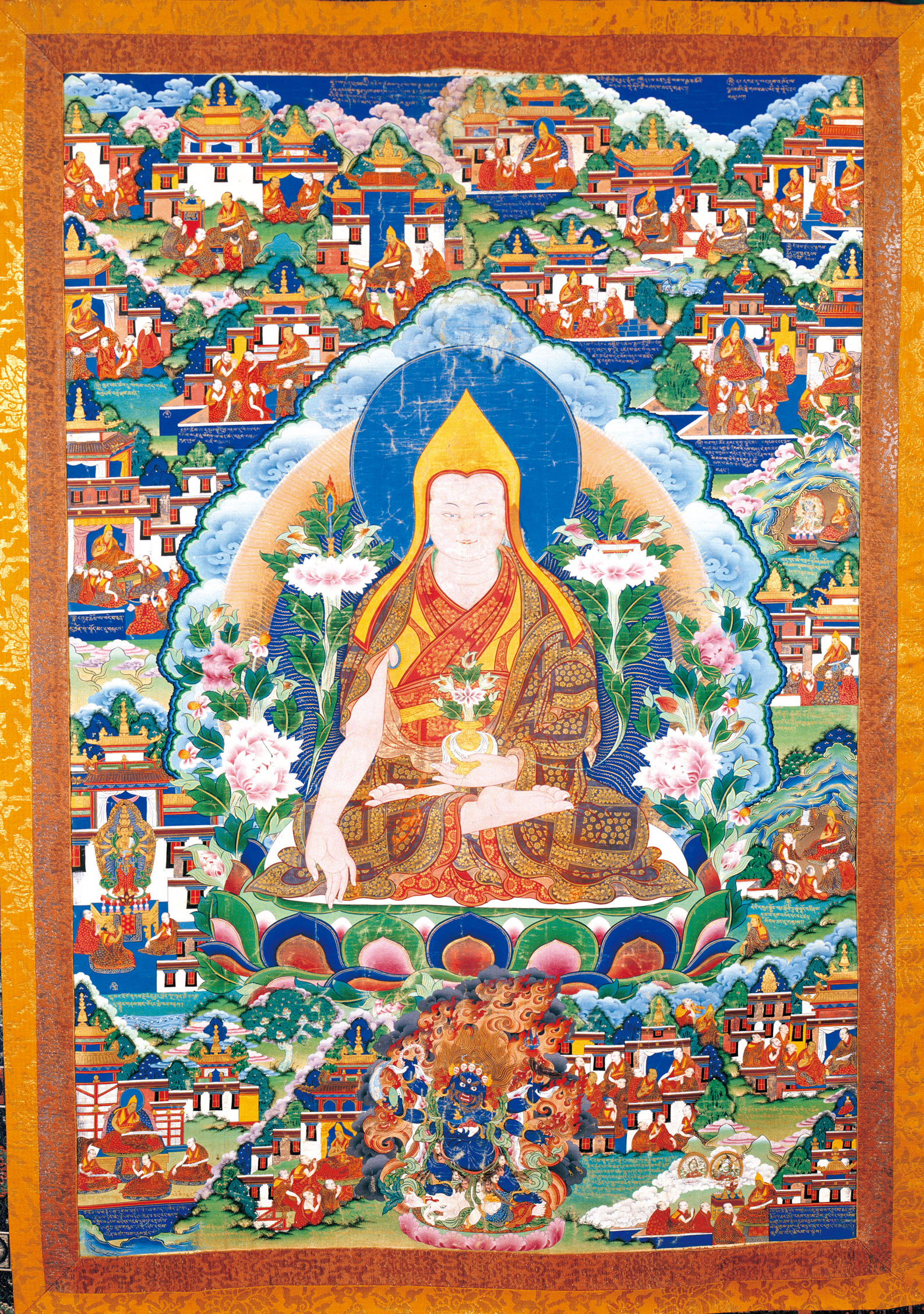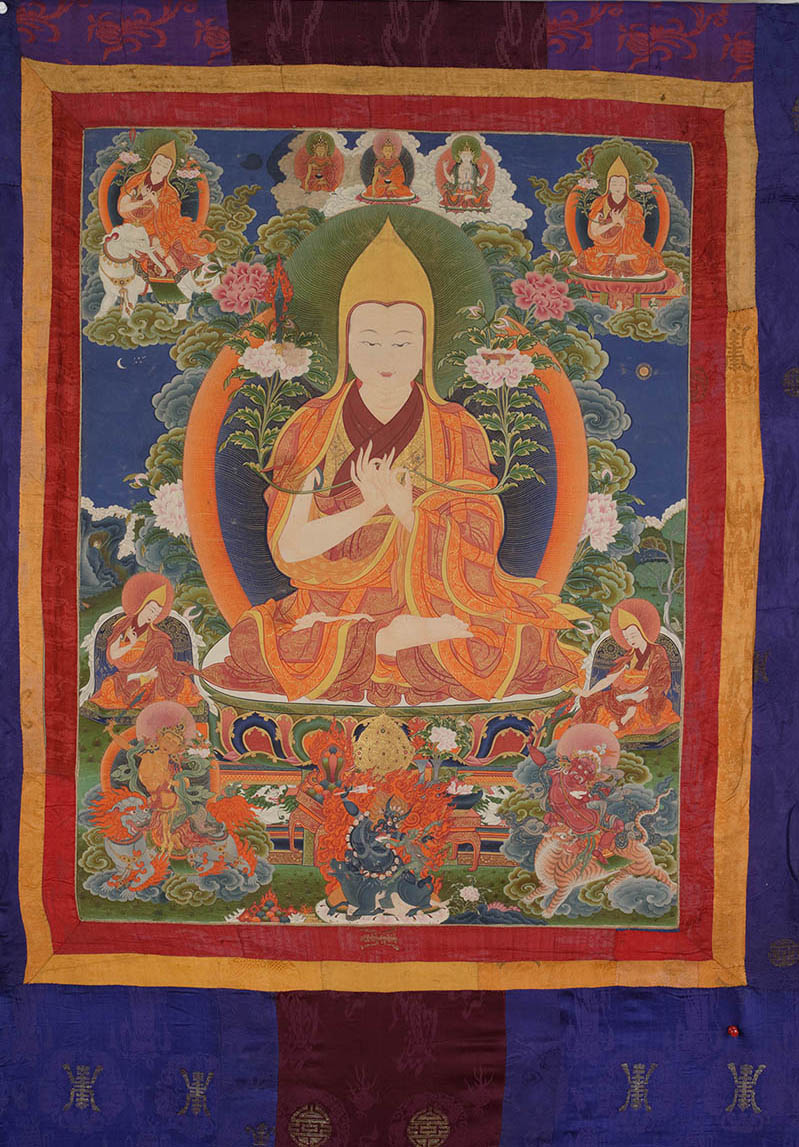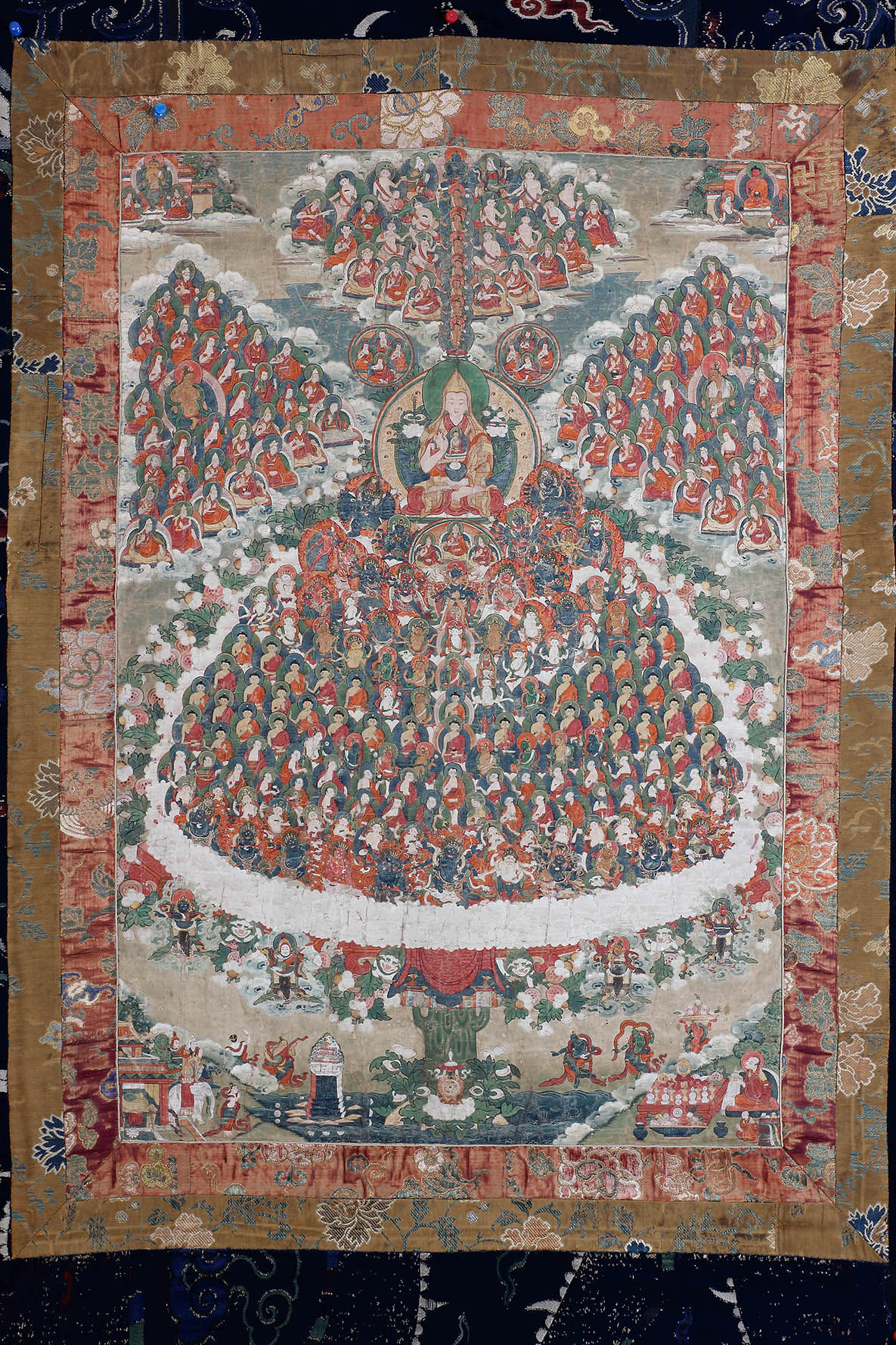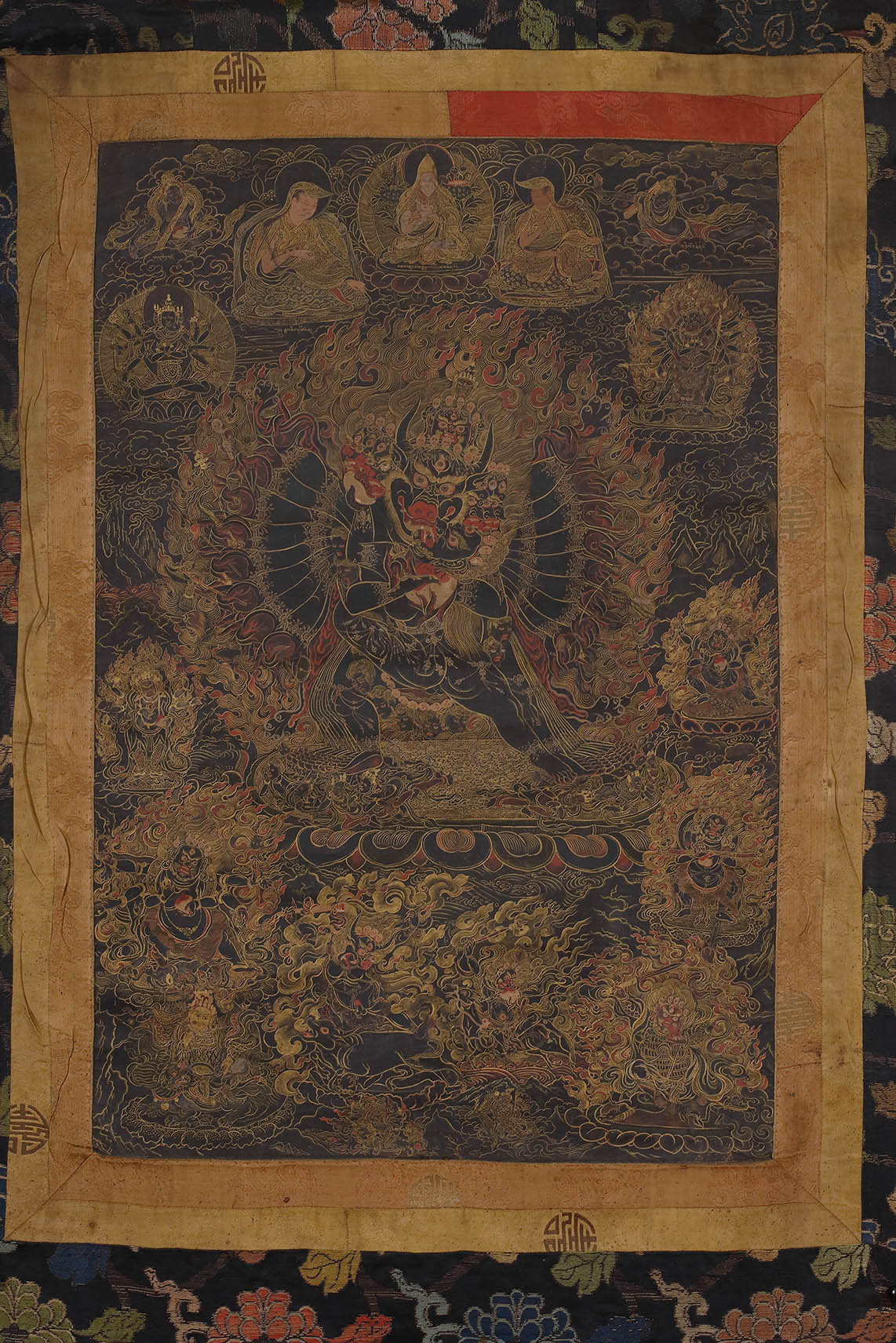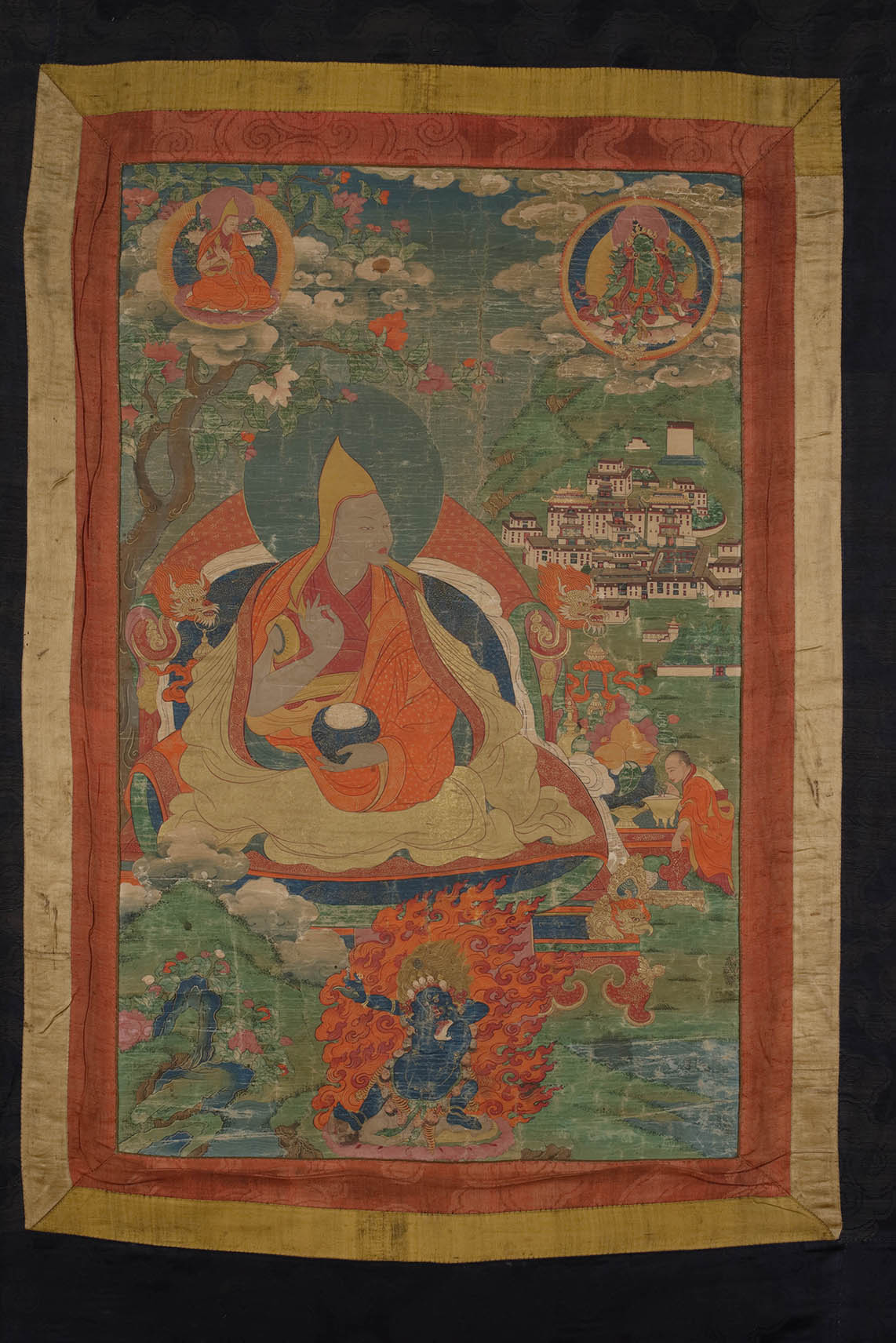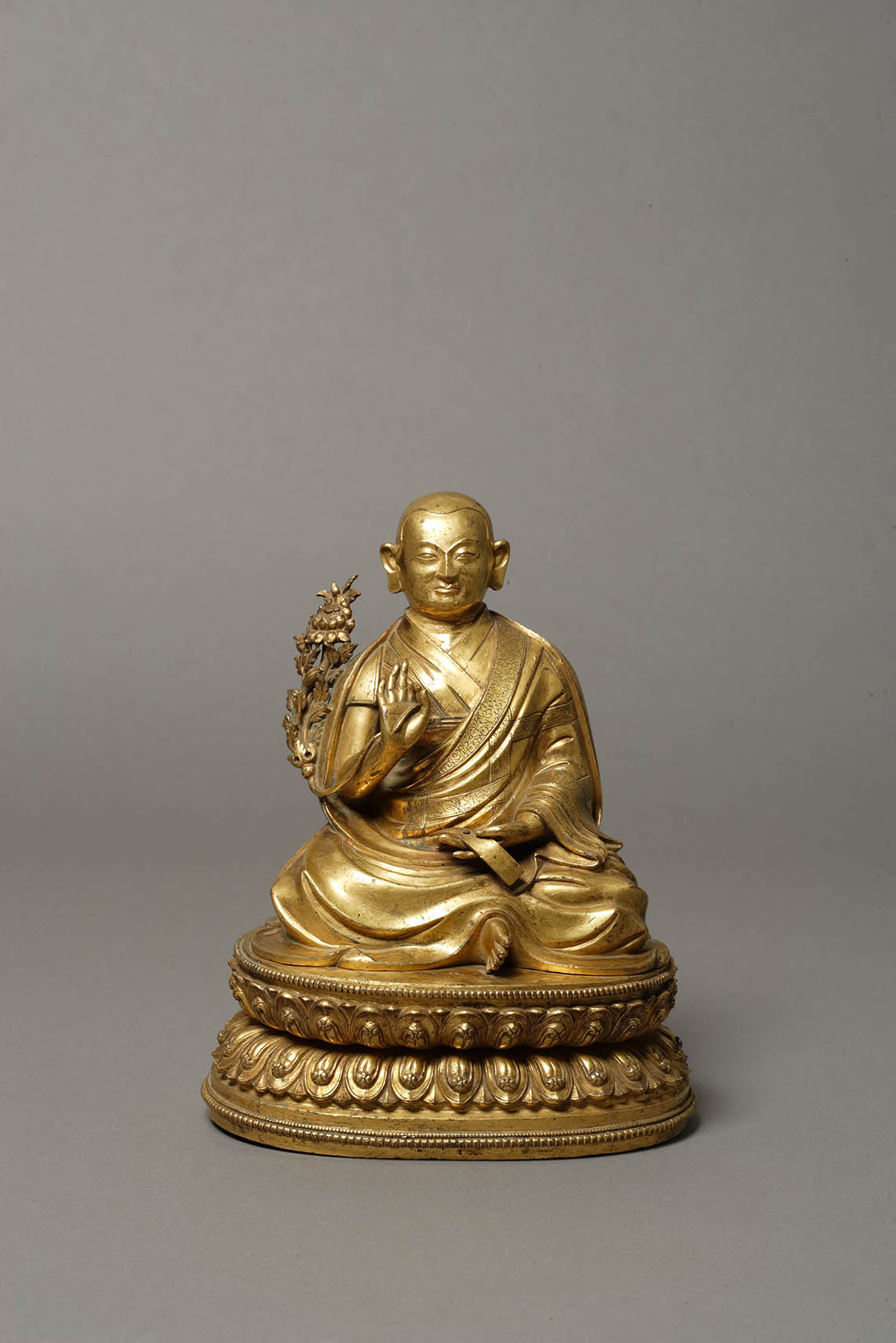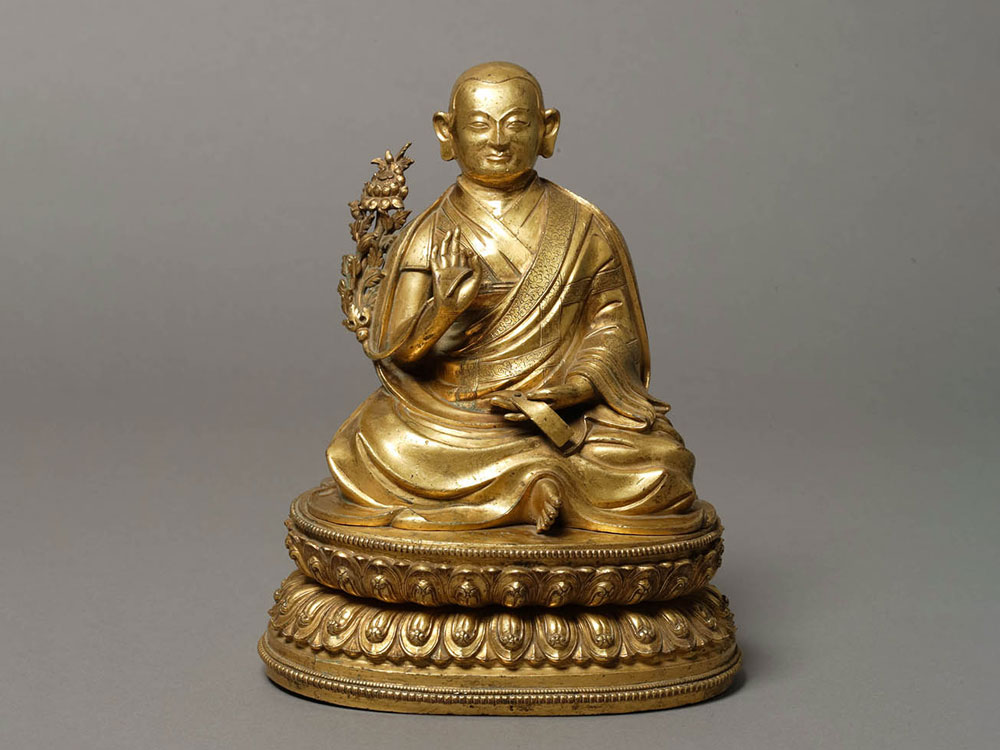The Qing Court and Khubilghans
The term huofo (living Buddha) first appeared in Chinese Buddhist texts of the Yuan dynasty, but it was not until the mid-Ming dynasty that it came to mean a reincarnated Tibetan Buddhist high monk. However, the term remained in popular usage and was not official nomenclature. When endorsements of living Buddhas were referred to in Qing official documents, the term adopted was the transliterated Mongolian khubilghan, which was interpreted by the Qianlong emperor as "a reincarnated spirit." This section of the exhibition starts with the origin of the Chinese term huofo and describes what early Qing emperors (the Shunzhi, Kangxi, Yongzheng and Qianlong emperors) saw in khubilghans, and how they interacted with them. It also presents a variety of artifacts to provide an overview of the development of the Gelug School and its distinctive characteristics.
The Gelug School that Gained Prominence in the Qing Dynasty
The display of key iconography and statues in this sub-section provides an overview of the important deities and masters of the Gelug lineage towards a better understanding of the background and special characteristics of the School and its influence on the Qing court's religious faith.
Gold statue of Tsongkhapa
- Cast by imperial workshop, 46th year of the Qianlong reign (1781), Qing dynasty
In the 44th year of the Qianlong reign (1779), the Sixth Panchen (1738-1780) set off from the Tashi Lhunpo Monastery for Beijing to celebrate the emperor's 70th birthday. The religious leader arrived in Chengde the following year and was received by the emperor in the Summer Resort. Among the Sixth Panchen's numerous birthday tributes to the Qing court was a statue of Tsongkhapa (1357-1419) on a gold pedestal. The Sixth Panchen died of smallpox in Beijing in late 1780. The following year, the Qianlong Emperor ordered three statues modeled by the Imperial Workshop on the Tsongkhapa statue the Sixth Panchen had presented to him in commemoration of the religious leader. Of the three, two were cast in copper alloy and are now housed in the Palace Museum in Beijing. The third, made of pure gold and originally stored in the Summer Resort in Chengde, is now in the National Palace Museum collection in Taipei. According to the inscription behind the mandorla, this golden statue was modeled after the Tibetan original in the 4th month of the 46th year of the Qianlong reign (1781). The figure of Tsongkhapa is performing the vitarka mudrā, a gesture symbolizing discussion and transmission of Buddhist teaching, in front of his chest. He holds a lotus flower in each hand, with a sūtra book on top of the left lotus and a sword on top of the right one. Both sword and sūtra book symbolize wisdom and indicate that the founder of the Yellow Sect was a manifestation of Mañjuśrī.
Leaves of fragrant white sandalwood with veins in the shape of a mystical Tibetan character in a leather box
- Qianlong reign (1736-1795), Qing dynasty
The leaves of fragrant white sandalwood with veins in the shape of a mystical Tibetan character are stored in a rectangular lacquerware box. The several dry brown leaves, twigs, and bark are separately wrapped in yellow paper, and the pieces of yellow paper are marked with the Tibetan characters oṃ, pa, da, hūṃ, and ra. The white textile in the box is inscribed with text in Chinese, Manchu, Mongolian, and Tibetan scripts.
The Chinese text reads, "In the 14th year of the Qianlong reign, the Changkya Khutukhtu received an imperial order to retrieve from Fanzongsi Monastery in Amdo the bark, leaves, and flowers marked with Tibetan characters of the fragrant white sandalwood that grew on the spot where the blood dropped from Tsongkhapa's umbilical cord when he was born." It has been reported that today this white sandalwood tree is still standing.
Important Events in Tsongkhapa's Life
- Produced in central Tibet, late 18th to 19th century
- Collection of Hung's Arts Foundation
Written on the back of the mount is g.yon gnyis pa (second from the left), indicating that this is part of a series of thangkas on the life of Tsongkhapa, who is featured in the center of every painting, making a different hand gesture or holding a different object. Under Tsongkhapa are various deities and dharmapālas, while surrounding him are his life stories with Tibetan inscriptions.
In this thangka, Tsongkhapa is depicted as wearing a yellow hat, making the varada mudrā (gesture of wish granting) with his right hand and the dhyāna mudrā (gesture of meditation) with his left, and sitting cross-legged on a lotus throne. He holds two lotus stems that support a manuscript and a sword. The pandit's hat was originally red, but following what he saw as a lack of discipline in Tibetan Buddhism, Tsongkhapa vowed to introduce reforms and in 1388 started wearing a yellow hat, which symbolized a continuation of the Indian Buddhist Sarvāsti-vāda School passed on by Śākyaśrībhadra (1145–1244) of Kashmir. Later on, the yellow hat became a symbol of the Gelug School, which is also known as the "Yellow Sect."
This thangka is of the Menbris Sama style, which is characterized by the shading of the flowers, the use of gold ink to trace branches, leaves, and patterns on monastic robes, mushroom-shaped clouds, and life stories in diamond-shaped spaces framed by diagonal trees and clouds. This large-scale work with splendid saturated colors was produced in a major monastery in Tibet.
Five Manifestations of Tsongkhapa
- Produced in Luhuo, Sichuan, late 18th century to 19th century
- Private collection
This thangka combines two motifs relating to Tsongkhapa: the first is the trio consisting of Tsongkhapa and his two disciples rGyal tshab rje (1364-1431) and mKhas grub rje (1385-1438, posthumously recognized as the First Panchen), and the second is the five manifestations of Tsongkhapa.
When Tsongkhapa passed away, mKhas grub rje encountered difficulties in his practice and prayed for guidance from his mentor. It is said that mKhas grub rje had five visions of his mentor: as a monk riding on an elephant (upper left), a monk seated on a throne supported by gods and goddesses (upper right), Mañjuśrī riding on a lion (bottom left), Mahasiddha riding a tiger (bottom right), and in his usual attire (center).
The overall arrangement of heavy coloring in this work is rendered in the Menbris style of thangka painting. The portrayal of facial expression is neat and delicate, so are the depicting lines. The olive-painted grass in the foreground, the twisted rocks in the background, and the hidden Jêbzün Milaräba (1052-1135), a major figure of the Kagyu School, show that this is a piece in the style of the thangkha master Nam mkha' rgyan (active 17th century) from Luhuo, Sichuan. It has been told that Nam mkha' rgyan was skilled at painting miniature Buddhist portraits, and often concealed in his works images of such non-Gelug masters as Padmasambhava and Jêbzün Milaräba.
Rfuge Field of the Gelug School
- Produced in Lhasa, 18th century
The imagery of Refuge Field also referred to as Refuge Field or Refuge Tree because of its tree-shaped structure, is a visualization of Buddhist practice that includes lineage teachers, Buddhas and bodhisattvas, and Esoteric Buddhist Yidams, Dakas, and Dharmapālas. This work is a Refuge Field of the Gelug School.
In the center is the founder of the School Tsongkhapa, directly above are generations of teachers, on the left the Madhyamaka lineage (headed by Mañjuśrī), on the right the Yogācāra lineage (descending from Maitreya), and below are Esoteric Buddhist Yidams, Buddhas, Bodhisattvas, Śrāvakas, Pratyekabuddhas, Dharmapālas, and Dakas. In the upper left- and right-hand corners are Amitābha's Pure Land and Maitreya's Pure Land, which practitioners can access once they have accumulated sufficient merits.
Portrait of Yamāntaka
- Produced in Tibet, 18th to 19th century
- Private collection
This portrait features gold lines on a black background and is decorated with red. This "black thangka" technique is often used to depict wrathful deities that manifest in darkness, with the red colors portraying locks of hair, flames, blood, or lotus petals. The work presents a typically Gelug School motif: the main deity Yamāntaka flanked by Guhyasamaja and Cakrasaṃvara towards the top are the three Yidams most revered by the Gelug School, and Yamāntaka is the most important of the three.
In the center is the trio consisting of Tsongkhapa and his two disciples. At the bottom are Dharmapālas commonly associated with the Gelug School, including Palden Lhamo, the six-armed Mahākāla, Yama, and Vaisravana.
Portrait of the First Dalai Lama
- Produced in Tibet, 18th century
- Private collection
This portrait is from the Origin of the Dalai Lineage, a collection of 13 portraits created during the time of the Seventh Dalai Lama (1708-1757). The collection centers around the Seventh Dalai Lama, and in addition to the portraits of the First to the Seventh Dalai Lamas, it also includes previous reincarnations, such as Cittavishramana, the Indian king dKon mchog ‘bangs, the King of Tibet Songzän Gambo (r. 629-650), and the founder of the Kadam School 'Brom ston pa (1005–1064). The First Dalai Lama Gedun Drupa (1391-1474) was a disciple of Tsongkhapa in the latter's later years and the founder of the Tashi Lhunpo Monastery in Xigazê. The Tashi Lhunpo Monastery is shown in the background of this thangka, while Tsongkhapa is depicted in the hollow above the head of Gedun Drupa.
Statue of the Second Dalai Lama
- Made in central Tibet, mid-17th century
- Collection of the Garuda Tibetan Art Studio
The inscription on the back of the lotus throne indicates that this work is "tenth from the left" of a series of statues, and the figure is dGe ‘dun rgya mtsho (1475–1542), the Second Dalai Lama. Judging from extant works and the style of this piece, the set of Dalai Lama statues contains at least 23 works. Its large size, exquisite quality, and beautiful gilding show that it was likely an important and costly production made during the time of the Fifth Dalai Lama (1617-1682).
As a young boy, the Second Dalai Lama was proclaimed the reincarnation of the First Dalai Lama, Gedun Drupa. Renowned for his scholarship, the Second Dalai Lama grew to become an important leader of the Gelug School.
